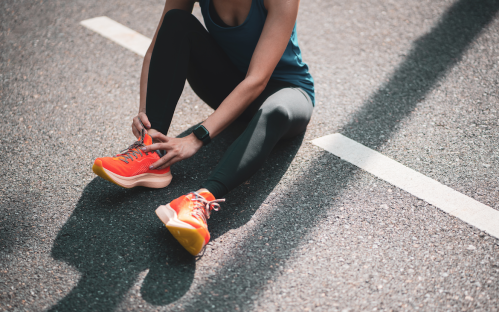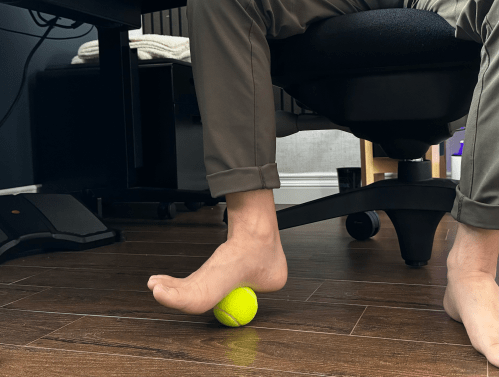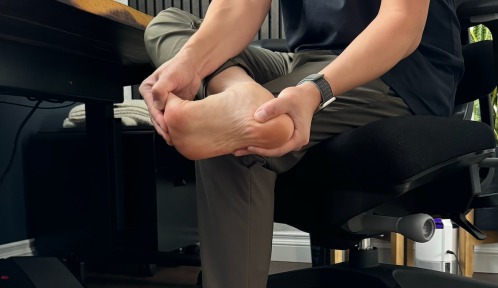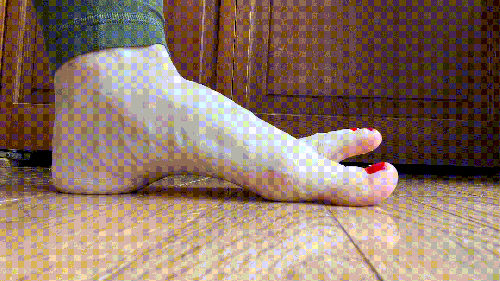These 7 Plantar Fasciitis Exercises Can Help Ease Your Foot Pain—Fast
Quicker healing and less discomfort? Yes, please. These seven plantar fasciitis exercises will have you feeling better in no time.

Plantar fasciitis can be a particularly scummy injury. Anti-inflammatories don’t do much; ice doesn’t help. And if you let it linger, you could be waiting for over a year to find relief from chronic pain—and not just in your foot. “If you let [plantar fasciitis] go for too long, it can lead to other issues, like knee pain or hip pain,” says physical therapist Jacob VanDenMeerendonk, DPT.
Experts in This Article
physical therapist at New York’s Hospital for Special Surgery
physical therapist based in Southern California
The good news: Catch a flare-up early and start doing some plantar fasciitis exercises ASAP, and you might start to feel better in as little as a few days. “It’s highly effective to go see a physical therapist and get it treated,” says Dr. VanDenMeerendonk. The key is to address whatever’s causing your plantar fasciitis, and build the strength and mobility you need right away so that other body parts don’t begin to compensate for the pain.
If you’re ready to rid yourself of your heel pain, read on to find out more about what plantar fasciitis is—including how to tell if you have it—and learn a few plantar fasciitis exercises you can do at home to help your foot heal fast.
Why plantar fasciitis happens
We get plantar fasciitis when the bottom of our foot is too weak to handle the amount of stress we’re putting on it, and the tissue becomes irritated. “It’s actually not an inflammatory condition; it’s more of a hypersensitivity condition,” explains Dr. VanDenMeerendonk.
There are two main camps of people who typically end up with plantar fasciitis: Athletes (particularly runners) who ramp up their workouts too quickly, and people who aren’t very active so their feet can’t handle the stress of their body weight when they’re just walking around or standing—especially if they wear less-than-ideal footwear.
Unfortunately, this injury is pretty common. Daniel Supple, DPT, CSCS, a physical therapist at New York’s Hospital for Special Surgery, says that about 10 percent of all people1 will get plantar fasciitis at some point in their life. Those he sees most often for it are women in their 40s to 60s.
How to tell if you have plantar fasciitis
Just because the bottom of your foot is aching doesn’t necessarily mean you have plantar fasciitis. True plantar fasciitis will present as pain on the bottom of the foot toward the inside of the heel, especially during the first few steps of the morning or if you’re pressing on that area with your fingers, says Dr. Supple.
You can also check for plantar fasciitis by flexing your foot and stretching your big toe back toward your shin. “If you have pain in the middle of the foot or in that heel area, that’s a positive test,” says Dr. Supple. Of course, it’s best to see a physician for a real diagnosis, but these signs can point you in the right direction.
Plantar fasciitis exercises and stretches
If you’re diagnosed with plantar fasciitis, there are two kinds of exercises a physical therapist might prescribe. “We can do things that make it feel better, and then things that make it actually better,” says Dr. VanDenMeerendonk.
Fortunately, you can do both types of plantar fasciitis exercises every day, says Dr. Supple. “They’re not super aggressive or too strenuous,” he says.
1. For pain relief: Foot arch massage

Just like you might foam roll stiff muscles, rolling out the bottoms of your feet can provide immediate relief, says Dr. VanDenMeerendonk.
- 1.Either seated or standing, place your foot on top of a small ball like a lacrosse or tennis ball, or even a frozen water bottle.
- 2.Roll forward and backwards from the heel to the ball of your foot, applying enough pressure to massage the tissue.
2. For pain relief: Plantar fascia stretch
Stretching the fascia can help to calm down the hypersensitivity of the tissue.

- 1.Sit in a chair with one ankle placed on the opposite knee in a figure-four position.
- 2.Use your hands to stretch the toes—either the big toe or all five toes, whichever feels best—back towards the shin until you feel a stretch in the bottom of your foot.
- 3.Hold for about 10 seconds, and aim for 10 reps.
3. For prevention and pain relief: Calf stretch up the wall
Stretching out your calf can help keep plantar fasciitis at bay. “If the calf muscle is too tight, that can lead to plantar fasciitis,” says Dr. VanDenMeerendonk. It’s also useful for decreasing your discomfort. “There is some evidence that calf stretching can calm down the [pain] receptors on that area and make the body a little less irritated,” says Dr. Supple. This move stretches both the calf and plantar fascia.

- 1.Place a bare foot up against a wall with the toes extended up the wall.
- 2.Lean your hips forward to the wall to stretch the calf muscle and the plantar fascia simultaneously.
- 3.Hold for 10 seconds, then release. Repeat for a total of 10 times.
4. For a stronger plantar fascia: Calf raises on a towel
Doing these calf raises can strengthen the bottoms of your feet.

- 1.Standing with both feet parallel and your knees straight, place a rolled-up towel under your toes.
- 2.Lift your heels up, then slowly lower.
- 3.Aim for 12 to 20 reps, and do two or three sets.
Once that’s comfortable, you can also try picking up one foot at a time to do single-leg calf raises (holding onto something stable, like a counter, for balance).
5. For stronger plantar fascia: Barefoot balance exercises
Doing balancing exercises without shoes on requires the foot to manipulate the ground to keep you upright, strengthening the plantar fascia, says Dr. VanDenMeerendonk.

- 1.Start by balancing on one leg without shoes or socks on, seeing how long you can hold the position without falling.
- 2.If you want more of a challenge, try turning your head left and right, or closing your eyes while balancing.
- 3.Then, progress to the three-point star: Point the leg you’re not standing on to the front, then to the side, then the back, all while holding your balance.
6. For stronger intrinsic foot muscles: Toe yoga

Developing the motor control of the internal muscles of the feet can go a long way in keeping them healthy. This exercise can help keep plantar fasciitis from recurring. “A lot of people don’t have [the] ability to move individual toes,” says Dr. Supple. Toe yoga challenges that coordination and strength.
- 1.Start with your feet flat on the floor, either while seated or standing.
- 2.On the injured foot, keeping your four smaller toes on the ground, lift up just the big toe. Then place it back down, and repeat 10 to 20 times.
- 3.Keeping your big toe on the ground, lift up just the little toes, then place them back down, 10 to 20 times.
- 4.Then, lift up all your toes, spreading them out wide, and place them down one after another, in a wave-like pattern. Try going in both directions, 10 to 20 times.
7. For a stronger arch: Doming
This move builds the muscles in your arch.

- 1.Start with your feet flat on the floor, either while seated or standing.
- 2.Squeeze the ball of your injured foot toward your heel to make your arch pop up, keeping your toes long.
- 3.Hold for a few seconds.
- 4.Relax to flatten your foot back out again.
- 5.Repeat 3 or 4 times.
Other steps to take
Getting the pain under control by doing these plantar fasciitis exercises is only the first step; you also want to make sure it won’t flare up again.
If you’re a runner, “once you decrease that pain, you want to make sure that you’re getting a good assessment of how you run,” says Dr. Supple. Most physical therapists or running coaches are able to watch your gait and make suggestions on how to improve your biomechanics.
Whether you walk or run, you also want to make sure your shoes have the proper cushion and support to keep your feet healthy. Dr. VanDenMeerendonk also has some runners use zero-drop barefoot shoes strategically to help strengthen their feet. “They’re not using those shoes to run their marathons, but they are using that as a training mechanism [on] light jogs to strengthen their feet,” he says.
And don’t forget about conditioning the rest of your body. Dr. Supple says there’s evidence to suggest that stronger glutes in particular can reduce your risk of developing plantar fasciitis by improving your gait pattern. So keep up those squats, deadlifts, and glute bridges to strengthen your backside along with these plantar fasciitis exercises to maintain your foot strength and mobility.
How quickly you can expect results
These plantar fasciitis exercises should start to help the pain within a couple of weeks at least. If you’re not feeling any improvements by then, seek out an orthopedic clinical specialist or a sports clinical specialist who has experience treating plantar fasciitis.
“You can do these self-stretches and things at home, but it should start getting better within a few days. And if it’s not, go see a PT,” says Dr. VanDenMeerendonk. “Get it treated now before it turns into something else.”
Buchanan BK, Sina RE, Kushner D. Plantar Fasciitis. [Updated 2024 Jan 7]. In: StatPearls [Internet]. Treasure Island (FL): StatPearls Publishing; 2024 Jan-. Available from: https://www.ncbi.nlm.nih.gov/books/NBK431073/
↩︎
Sign Up for Our Daily Newsletter
Get all the latest in wellness, trends, food, fitness, beauty, and more delivered right to your inbox.
Got it, you've been added to our email list.










